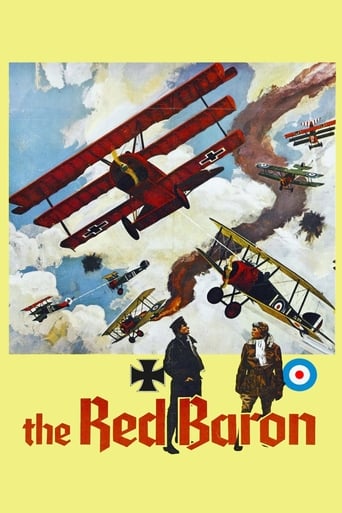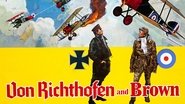MartinHafer
John Phillip Law is cast in the role of Baron Von Richthofen and Don Stroud as Roy Brown--the man who is PARTIALLY credited with killing the Red Baron. The real stars of the show, however, are the airplanes. Now I am not saying the aerial scenes were well done--they were at best fair because you rarely knew who was shooting at who, and so it often just seemed very random. As for the acting, it was pretty one-dimensional (especially Stroud) and this was mostly due to the writing. In addition, while SOME of the details are correct, others are not--so you can't exactly see this as a bio-pic--more like a fictionalized look at BRIEF periods of the lives of both men. One serious problem with the film is the final scene where Brown shoots down Von Richtofen--as there was SIGNIFICANT ground-fire and most experts believe this actually caused the Red Baron's plane to crash, not Brown! Yet, inexplicably, there are no soldiers on the ground--none--and the credit goes entirely to Brown--who was, for the most part, a rather unremarkable pilot otherwise."Von Richthofen and Brown" is a competent enough movie to merit your watching it. However, it is far from a great aviation film--mostly because the characters are so one-dimensional and because the film seems more fiction than biography. Instead, you may consider better WWI aviation films like "The Dawn Patrol" (either version), "Wings" or "The Blue Max".
Andres Salama
An entertaining movie about the World War I exploits of the ace German pilot Manfred Von Richthofen's (aka, the Red Baron) and his main opponent, Canada's Arthur Brown.The aristocratic Von Richthofen is so honor bound that he refuses to use camouflage paint on his planes, because "a gentleman should never hide from his enemies" and instead paints them with the brightest colors. The pragmatic, no-nonsense Brown, instead, does not believe in honor or chivalry: he just wants to win.I can't vouch for the complete historical authenticity of this movie – to mention just one instance, the actor portraying Hermann Goering looks nothing at all like the future Reichsmarshall, and his role in the flying circus was not as prominent as the movie implies. But as an entertainment (by the well known horror low budget film director Roger Corman) this movie is certainly well done. Sure, there is some corny dialogue here and there, and having Von Richthofen speak English in the movie with a heavy German accent was probably not the best idea, but the magnificent shots of period planes fighting in the air over the patchwork fields below separated by hedgerows (shot in 1971 with fearless stunt men, well before digital imagery started appearing in films) more than makes up for this movie's shortcomings. The great color photography is another plus.
Etherdave
John Philipp Law and Don Stroud respectively play the two men named in this film's original title, Von Richtofen And Brown, and presents a fairly balanced and interesting set of parallels and divergences between the two men. As World War One rages to its conclusion, Von Richtofen and Brown head on a collision course towards their fateful encounter in the air.Corman's production is a bit dated, and purists will point out many technical and historical errors in the film. Flight and combat sequences, however, are exciting, extremely well-conceived and filmed, and surpass most efforts before or since to show film-goers aerial combat of the First World War.I saw this film at a drive-in when it was first released, and it still fascinates me to this day. While other more-expensive productions, with their sumptuous sets and A-list actors, continue to command the attention of film viewers and film collectors alike, I find the simple, sparing lines of this production far more effective as the vehicle for one of history's most famous duels. True, by now most historians have abandoned the notion that the fatal bullets came from Brown; however, this is the tale of popular culture as it was told for generations, not as nuclear scientists have most lately emended it.
kayma2
It is pointed out that "goofs" were made in the making of this film. (A) Von Richofen is depicted flying a Fokker D-VII over a year before the plane was actually introduced (and prior to flying the Triplane) (B) Brown's squadron is shown flying SE 5s when in actuality, they were equipped with Sopwith Camels.I suspect these were intentional choices on the part of the director. Von Richtofen's plane in early 1917 was actually an Albatros D5 - an improvement over the earlier D3, but having an unfortunate tendency to shed its wings in a dive. Even if this were corrected in a modern reproduction, the Albatros design is nose-heavy and difficult to control.The Sopwith Camel, while an effective fighting machine, was called th "Widow-maker" for good reason. It's extremely high-torque rotary engine made it very difficult to fly and very unforgiving of mistakes. The SE 5 and 5a, on the other hand were fairly stable craft and easier for novice pilots (they've been used exclusively in other WW I films).Only hard-core WWI historians would have noticed these inconsistencies, and I suspect the choices were made for the safety of the stunt pilots. Don't let them stop you from enjoying some great aerial combat scenes.Incidentally, the events that were reversed were the circumstances of von Richtofen's crashes. In the first one, he is depicted as crash landing, while in the second (fatal) one, the plane actually lands quite well by itself (this would NEVER have happened in a Fokker triplane!)It was actually the other way around. The first time, the wounded von Richtofen managed to bring his Albatros to a landing. The second time -already dead before he hit the ground - the plane crashed in no-man's land near an Australian unit who may indeed have hit him from the ground.






